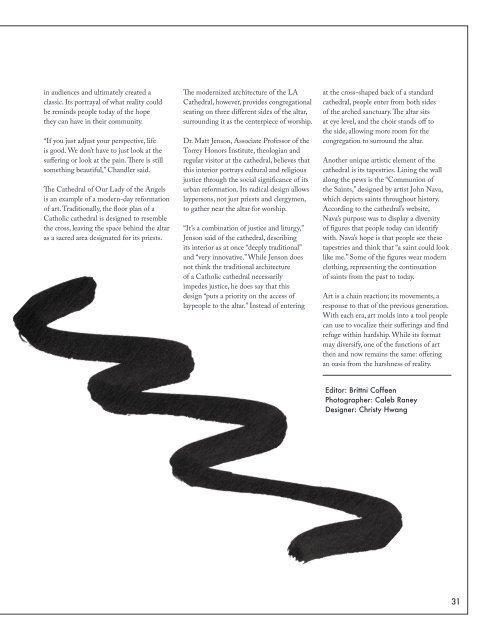The Point: Spring 2018
Spring 2018 | Volume 13 | Issue 2
Spring 2018 | Volume 13 | Issue 2
- No tags were found...
You also want an ePaper? Increase the reach of your titles
YUMPU automatically turns print PDFs into web optimized ePapers that Google loves.
in audiences and ultimately created a<br />
classic. Its portrayal of what reality could<br />
be reminds people today of the hope<br />
they can have in their community.<br />
“If you just adjust your perspective, life<br />
is good. We don’t have to just look at the<br />
suffering or look at the pain. <strong>The</strong>re is still<br />
something beautiful,” Chandler said.<br />
<strong>The</strong> Cathedral of Our Lady of the Angels<br />
is an example of a modern-day reformation<br />
of art. Traditionally, the floor plan of a<br />
Catholic cathedral is designed to resemble<br />
the cross, leaving the space behind the altar<br />
as a sacred area designated for its priests.<br />
<strong>The</strong> modernized architecture of the LA<br />
Cathedral, however, provides congregational<br />
seating on three different sides of the altar,<br />
surrounding it as the centerpiece of worship.<br />
Dr. Matt Jenson, Associate Professor of the<br />
Torrey Honors Institute, theologian and<br />
regular visitor at the cathedral, believes that<br />
this interior portrays cultural and religious<br />
justice through the social significance of its<br />
urban reformation. Its radical design allows<br />
laypersons, not just priests and clergymen,<br />
to gather near the altar for worship.<br />
“It’s a combination of justice and liturgy,”<br />
Jenson said of the cathedral, describing<br />
its interior as at once “deeply traditional”<br />
and “very innovative.” While Jenson does<br />
not think the traditional architecture<br />
of a Catholic cathedral necessarily<br />
impedes justice, he does say that this<br />
design “puts a priority on the access of<br />
laypeople to the altar.” Instead of entering<br />
at the cross-shaped back of a standard<br />
cathedral, people enter from both sides<br />
of the arched sanctuary. <strong>The</strong> altar sits<br />
at eye level, and the choir stands off to<br />
the side, allowing more room for the<br />
congregation to surround the altar.<br />
Another unique artistic element of the<br />
cathedral is its tapestries. Lining the wall<br />
along the pews is the “Communion of<br />
the Saints,” designed by artist John Nava,<br />
which depicts saints throughout history.<br />
According to the cathedral’s website,<br />
Nava’s purpose was to display a diversity<br />
of figures that people today can identify<br />
with. Nava’s hope is that people see these<br />
tapestries and think that “a saint could look<br />
like me.” Some of the figures wear modern<br />
clothing, representing the continuation<br />
of saints from the past to today.<br />
Art is a chain reaction; its movements, a<br />
response to that of the previous generation.<br />
With each era, art molds into a tool people<br />
can use to vocalize their sufferings and find<br />
refuge within hardship. While its format<br />
may diversify, one of the functions of art<br />
then and now remains the same: offering<br />
an oasis from the harshness of reality.<br />
Editor: Brittni Coffeen<br />
Photographer: Caleb Raney<br />
Designer: Christy Hwang<br />
31




